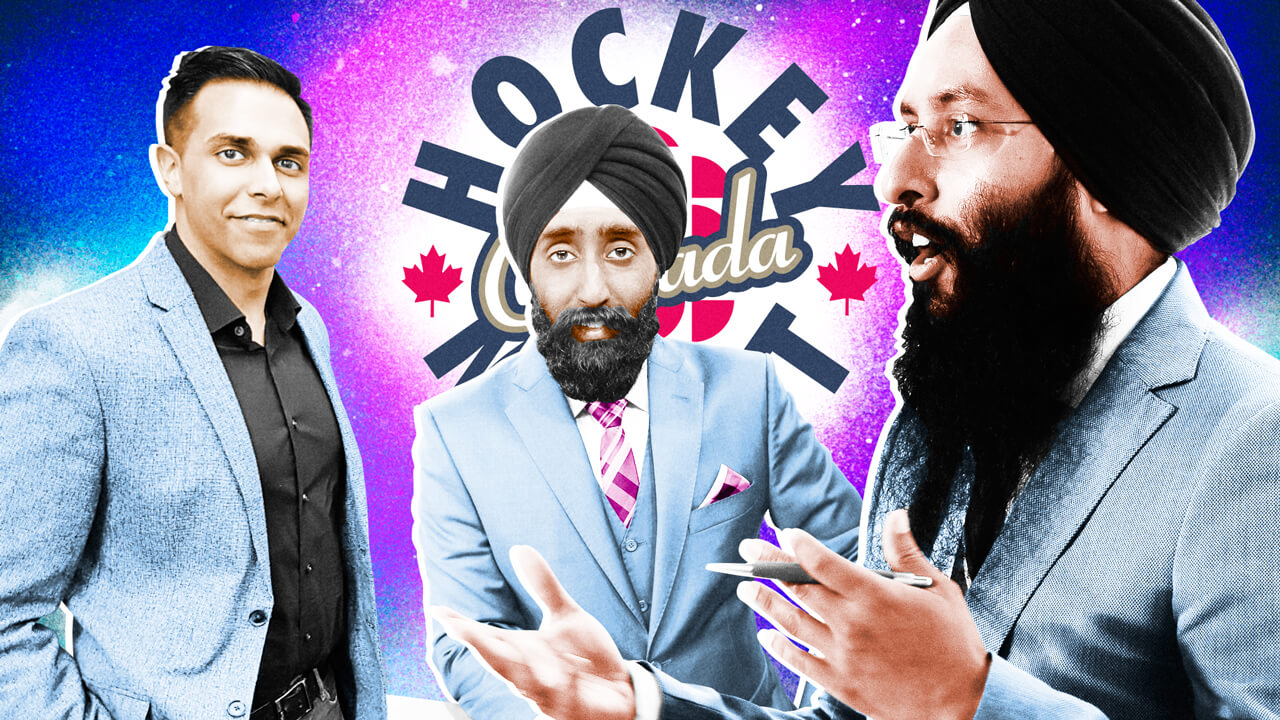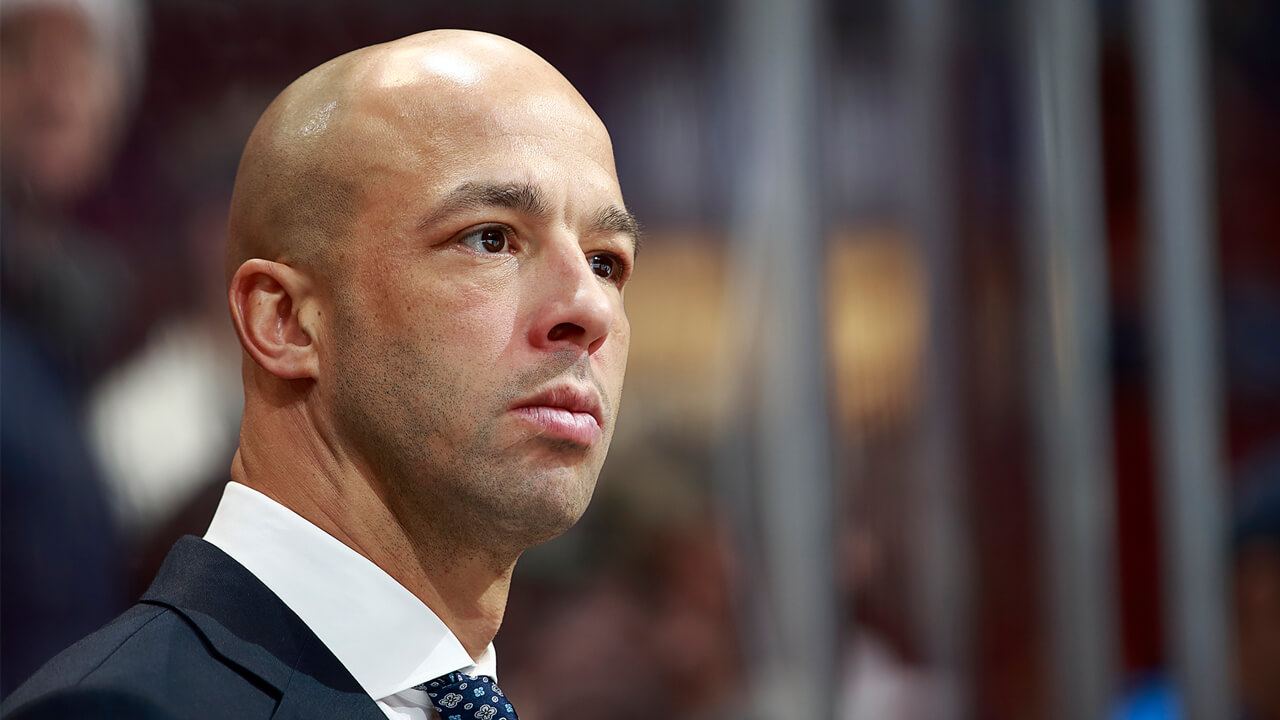

At first, Dampy Brar doesn’t notice all of the eyes on him. It’s 1997, early enough in the year that the heat you’d expect to seep into this Huntsville, Ala., arena is still a few months off, and the 20-year-old is just trying to catch a glimpse of himself in the glass. His reflection flashes purple-and-orange as he and his teammates trace half-speed circles on the ice, Brar draped in new colours for the third time this season, his first in pro hockey. This third club — the Central Hockey League’s San Antonio Iguanas — has given him the green light to go helmetless for this warm-up skate, a no-go during previous stops in Ohio and Tennessee.
So, young and rambunctious, Brar’s curling through the zone feeling like a stone-cold pro — no bucket, hair slicked back, quietly thrilled to finally be able to imitate the big-league vets he’s watched on TV his whole life. But out among the chestnut-and-navy seats, those eyes wait to remind him he’s not quite the image he’s long seen on-screen.
The stands at the Von Braun Center appear to float in mid-air. The bottom of the seats sit level with the top of the dasher boards, giving those on the ice the sense they’re in a fishbowl with the crowd looming above, peering in. When Brar, still moving through his pre-game laps, lifts his gaze up above the glass, he immediately notices all the eyes fixed on him, on his jet-black hair. The expressions he sees in the crowd are hard to place; there’s displeasure and irritation, but with a hesitance that dulls the edges.
More than anything else, the faces staring back at him seem confused, he thinks, and he’s got a pretty clear idea why: They’re trying to figure out his brown skin, and they’re failing, as if his skin itself is a conundrum, as if he’s got formulas scrawled across his cheekbones, quadratic equations stamped on his forehead. They’re baffled by him. And as they try to solve the puzzle, they continue staring, pointing, maybe trading theories of how he wound up here.
“I felt like an animal in a zoo,” Brar says now, thinking back on the moment.
In Canada, hockey is more than a sport. It’s a culture, a tradition and an identity. It unites a country. On April 17, join Molson and Sportsnet as they team up to deliver Hockey Night in Canada in seven additional languages: Cantonese, Mandarin, Hindi, Vietnamese, Tagalog, German and Arabic. Visit
sportsnet.ca/molson for full details.
Before Brar can second-guess his impression of the crowd, an onlooker makes his way down to the glass. Brar’s headed his way, en route to the bench to spit out the three pieces of bubblegum he’s been chewing throughout the warm-up skate — again, stone-cold pro. Stepping off the ice, he hears the fan toss out a bizarrely casual, “Hey, Black guy,” as he ditches the gum. “You’re not supposed to play hockey.”
Brar pauses, looking behind and beside himself for a moment. He turns back. “You talking to me?” he asks. Now he’s baffled, too, wondering if the name stitched to the back of his jersey isn’t a clear enough hint at his Indian roots.
He’s met with only a blank stare, so Brar gets free of the interaction the same way he has so many times before when similar efforts to break him down have been volleyed over the wall, and the same way many navigating the hockey world with more melanin do: He laughs it off, skates away and continues on.
Two decades removed from his on-ice career, Brar’s now working to rid hockey of those uncomfortable moments. The player-turned-coach is the co-founder of Apna Hockey, an organization working relentlessly to grow the game among Canada’s South Asian community. But, while he spends his time training everyone from young skaters with NHL dreams to older community members going for their first spin, Brar’s work is just as much about getting South Asians acquainted with hockey as it is the reverse. It’s about getting more people in the hockey world to a place where they see enough brown faces in enough places that, at the very least, they know what they’re looking at.
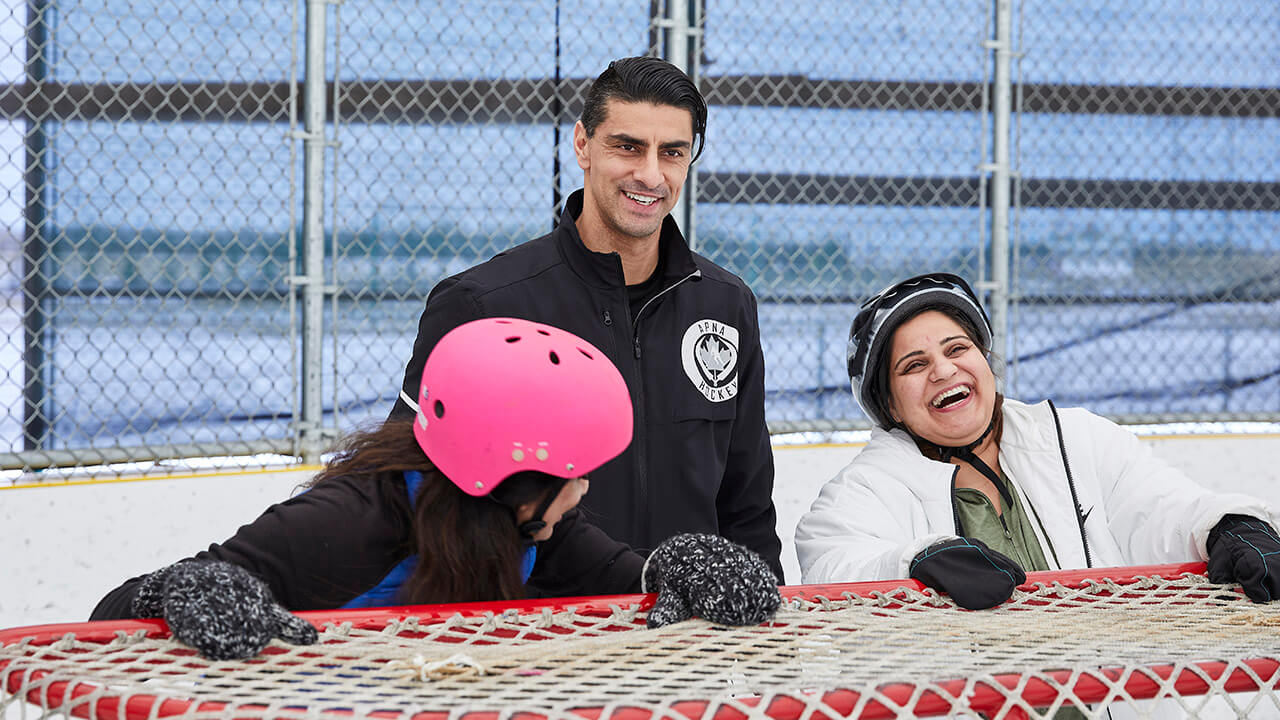
It wasn’t always as fraught as that Alabama warmup. Brar’s earliest days in the game were actually much the opposite. Growing up in the heart of the Rockies in Sparwood, B.C., he was beloved when he stepped on the ice. And somehow, in that remote coal-mining town of only a few thousand, Brar was rarely the only one on his young teams with brown skin and black hair poking out of his oversized helmet. In fact, it was seeing other young Sparwoodian hockey players who looked like him that first got Brar hooked on the sport.
“We all lived in these townhouses that were next door to each other, in front of each other, and I would see these Indian kids, the older kids, play hockey,” he says, remembering how he’d watch their games for hours on end before he was old enough to join in.
Eventually, he convinced his dad, Ram, to stop by the only store in town that sold hockey equipment to buy him a stick and puck. From that point, the obsession was sealed, Brar endlessly shooting his plastic puck into a milk crate in the family’s unfinished basement. Even when he was finally old enough to play actual games, they weren’t enough to scratch eight-year-old Brar’s hockey itch. “He would go play the game, come home, clear out the living room and he would play hockey with his little Hot Wheels cars,” his sister, Preet Bains, remembers. “Two opposing teams and then a little marble. And he’d play for hours. Like, this kid was non-stop.”
Such was his devotion, even other sports were bent to resemble hockey in any way possible. “If it wasn’t hockey, it was a sport based on hockey,” says Kam Heer, one of Brar’s closest friends from his Sparwood days. “We’d play baseball, but rather than use a baseball, we’d use a tennis ball, roll it on the ground, and use a hockey stick.”
The fact that seemingly every Indian family in the town had put their boys in hockey was more than a quirky sidenote to Brar’s story. It was essential to why he fell in love with the game, why he was able to convince his parents to let him play at all, why he didn’t feel the isolation in those younger days that many players of colour do. Sparwood hockey in the early ’80s was like a wrinkle in time and space — a tiny town hidden among the mountains where the more diverse vision of the sport many South Asian hockey fans dream of had already begun to take shape. “My parents, when they came to Canada, seeing a big East Indian population in Sparwood, the transition to going into hockey was very easy for them,” Brar says. “Because there were older [Indian] kids — five, six years older — that were playing hockey, it was easier for my parents to kind of trust and say ‘All right.’ … Actually having somebody that looked like me playing hockey — and a bunch of them, at all different age levels — it just made it easier for me to like the game.”
And what a shame it would’ve been had Brar not felt hockey was his to play. Because once he arrived on the ice, he flat out dominated. He lasted only two games in novice hockey as an eight-year-old, scoring a cool 20 goals between them, before his parents were told he’d have to move up and play with the 10-year-olds. So, on he went to roll with the older kids, to a team where four others in the locker room were Indian, too. A couple of years later, Brar’s scoring began to cause a ruckus once again when, acclimated to the uptick in skill, he took to scoring four, five, six goals a game. The association instituted a rule maxing players out at three a night. “So, in the first 10, 15 minutes of the game, I would get rid of my three goals,” Brar remembers with a laugh, “and then I would end up trying to set up my teammates.”
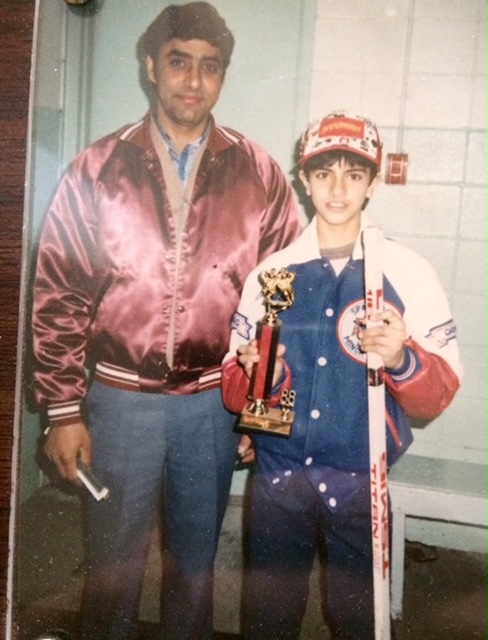
Junior B was the same story. After initially falling short of making the local Elk Valley Raiders because his 14-year-old frame was too small, Brar made the cut the next year. Despite taking Brar that second time out, the coach made sure to tell Ram his son was still too slight to thrive in the sport. But Brar put up four goals in his debut. “The whole town was talking about it,” his father beams.
Blessed with the chance to play on teams full of colour, Brar became something of a Sparwood legend. Parents and coaches tossed around comparisons to a young Wayne Gretzky, his mom Satwant remembers proudly. And when his team fell behind in games, there was one name the fans in the stands would chant: “All the parents, they would start saying, ‘Damps, turn your motor on! Damps, turn your motor on!’ And he brings the team back,” Satwant says.
For other Indian kids in the community, it was a thrill to see a Punjabi player roll through the opposition — just as it had been for Brar in his own younger days. “Being an East Indian in a mining town, to watch him play, it was a privilege,” says Heer.
And Brar’s skill was all the more impressive given the way on-ice development in small towns like theirs operated in those days. “Back then, we didn’t have the [hockey] camps that we do now, so everything that was done was literally done through himself, his desire to play the sport,” Heer says. “It was all his drive, his passion. No one was there to give him that [advice]: ‘Hey, you know, if you worked on this, you’d be better.’ It was, ‘I’ve got to do this myself.’”
In 1995, Brar’s drive carried him to Edmonton’s Concordia College. He figured it would be among his last stops in the sport, but his penchant for dazzling parents in the stands paid off, as it just so happened that one father had a pretty good eye for talent — Bill LaForge, the one-time coach of the Vancouver Canucks, who had guided NHL mainstays like Keith Primeau and Ken Daneyko during their junior days. It was LaForge who eventually took Brar aside and told him he had the chops to play pro hockey. So impressed was the former big-league coach, he helped Brar get a shot the very next season with the International Hockey League’s Las Vegas Thunder, at the time the minor-league affiliate of the NHL’s Phoenix Coyotes.
For a skinny kid from Sparwood who thought Alberta college hockey would be his peak, it was a gigantic leap — even before he stepped inside the rink. “I had never driven in a big city,” Brar says. “When we’d drive to Calgary, I’d drive to the outskirts and then my dad and I would flip seats, and he would drive in the city…. I mean, in Sparwood, there were no traffic lights, just stop signs.”
Even the step before the leap had seemed enormous. “My mom was always worried about me — she was worried when I was in Edmonton. She thought Edmonton was like Manhattan. They were like, ‘Oh my God, he’s living up in Edmonton.’ … Then the next year I’m in the States, and it was just an eye-opener. Freeways, concrete everywhere.”
This wasn’t exactly Middle America, either. It was Las Vegas in the ’90s. It was driving to practice at the Thomas & Mack Center, six minutes down East Harmon Ave. from the MGM Grand. “You hear about it on TV, and now you’re there…. It was crazy, just seeing a different lifestyle.”
He also had to figure out how to hold his own at what was by far the highest level he’d ever played. He wondered what he’d gotten himself into, but trusted LaForge’s belief in him. And sure enough, Brar — no stranger to a high-flying debut — put up enough points in the Thunder’s training camp intra-squad game to ignite a pro career, beginning with the ECHL’s Toledo Storm. After a few games there, and a few more with the Central Hockey League’s Nashville Nighthawks, he landed in San Antonio, ultimately topping 20 goals by the end of his rookie season with the Iguanas. The next year, he finally found stability with the West Coast Hockey League’s Tacoma Sabercats, his fifth pro team in two years, but the one with whom he’d go on to spend the next half-decade, win a championship, and become a genuine WCHL fan favourite.

Tacoma gave Brar a steady career as a pro, some numbers he could proudly hang his hat on and a fanbase that took to him wholeheartedly, but life as a brown hockey player in America wasn’t without challenges. He was crowned the club’s most popular player year after year, but that feeling of acceptance was rattled by moments similar to the one he’d experienced in Huntsville. It was more significantly shaken on Sept. 11, 2001. The events and aftermath of that morning forever altered the daily reality for all with brown skin. For some, that day-to-day was knocked just slightly askew; for others it was damaged irreparably. Brar was lucky to be plying his trade in a city that knew him beyond his brownness, that had accepted him already, but things got tougher the next year when he moved on to Boise, Idaho, for the final season of his career. There he found himself cornered in those uncomfortable situations once again, and more frequently — he recalls being particularly taken aback by one fan, who said hello by jokingly referring to him as a “little terrorist.”
Brar’s instinct was always to laugh it off — to be as open as he could in answering genuine questions and sharing his deep connection to his culture, while trying his best to block out the rest of the noise. But there were times when that approach was of little help. Flying, as any brown person living in the post-9/11 world can attest, was among the most tense experiences. “Anywhere we flew, I was always randomly searched,” Brar recalls of road trips in the tail end of his Tacoma days. “Every time randomly searched, every time the wand comes out.”
It was in those repeated moments of awkwardness that he saw his attempts at educating his teammates begin to bear fruit. Eventually, when Brar was stopped for the customary “random” search, his teammates began stepping in, asking why it was Brar who was always subjected to the extra measures. Even if they were met with the usual refrain — “He just came up in the system” — Brar appreciated it all the same.
On one particular trip home from a game in Alaska, an Anchorage airport security guard stopped Brar in the terminal, the “system” not even nearby to hypothetically bring up his name. “I was just walking by with six, seven teammates, and the guy goes, ‘Excuse me, sir. You.’ I’m like, ‘Yes?’ — ‘I need to search your bag.’” Brar’s teammates weren’t having it. “[One of my teammates] stepped in front and said, ‘No, he didn’t get flagged earlier,’ and the boys put up a front.” More security guards walked over to see what the fuss was about, Brar’s teammates repositioning and now standing between him and the original questioner. “They’re like, ‘This happens to him every time.’ And the other gentleman was kind of provoking the situation.”
Another request for Brar’s bag came, this time more aggressively. “No way,” a teammate at the front of the pack threw back. “Then search every one of our bags. Don’t just search his.” The situation was eventually diffused, the team going on its way. But Brar hasn’t forgotten what it meant to have that support. “It was nice to see that the boys had your back,” he says. “That’s what hockey, and team sports, is all about.”
If Brar’s story feels like a hopeful vision of hockey’s progress, his Apna Hockey co-founder Lali Toor’s feels the opposite. For Toor, there was no ascent in a diverse, puck-loving mountain enclave; no opportunity to truly see his potential through; no teammates shielding him from the barrage. It was because the two founders took such profoundly different paths, because their opposing timelines showed the full spectrum of the experiences of South Asians in the hockey world, that Apna Hockey was born.
Fifteen years after Brar first strapped on a pair of skates, a three-year-old Toor first stepped on the ice with his dad, who’d arrived in Edmonton from India just in time to see Wayne Gretzky and Mark Messier stockpile Stanley Cup rings, cementing his love of the game. While Brar came up in a town in which his skill reigned supreme, Toor made his bones in a competitive city that bred more than a couple of bona fide NHL stars. And he could hang with them, too — in 2000, at eight years old, Toor was playing in tournaments with some of the top young talents in the country, suiting up alongside future NHLers like Brendan Gallagher and Jaden Schwartz.
But despite showing as much early potential as Brar, there was one crucial element that separated Toor’s time in the sport from his future partner’s: Brar had the chance to see brown faces in the game all around him; Toor never saw a single one. “I learned a lot about how I was different,” he says. “I definitely looked different, I was treated very differently. I understood what racism was, unfortunately, at a very young age.” And he was reminded of that difference constantly, from all angles: “The coaches on my team. The coaches on other teams. The parents. The fans in the stands.”
Toor didn’t need a trip across the border to be confronted by the discomfort that had found Brar in Huntsville. It sought him out at home, on Canadian soil, and followed him doggedly through each practice, each game. He was nine years old when 9/11 knocked his daily reality off-kilter. The “terrorist” comments started soon after, along with others even more vile. And it kept snowballing, eventually shoving Toor off course at a time when those he’d once gone toe-to-toe with were moving on to the next key phase of their careers. “I felt like I was really hindered in my bantam AAA year, when I was supposed to be getting ready for the WHL Draft,” he says. “There were a lot of incidents that I wished I had a role model for. Someone that looked like me, that played at a high level.
“To be honest, I wish I knew Damps back when I was a kid.”
The two met in August 2017, and when they did, it seemed to both as if they’d been headed towards each other for years. The connection was so instant, in fact, it couldn’t be contained by the initial medium. Toor had already laid down the early foundation for Apna Hockey, creating a social media presence to highlight South Asian athletes in the sport. An Instagram message from Brar to wish Toor luck on the effort quickly turned into an impromptu phone call, which quickly turned into an hour-long drive to meet in person. “I wanted to really hear Lali’s story,” Brar says of what compelled him to suggest the hour-long trek the first time they ever spoke. “I could hear his emotion, his disappointment, his hurt, on the phone. And he goes, ‘Damps, you got to play pro hockey. You made it. You did things that I wanted to do.’”
They connected in Red Deer, the mid-point between Edmonton, where Toor was still residing, and Calgary, where Brar had moved. “I was like, ‘I need to see this guy’s eyes. I need to see him for real, what he went through,’” Brar remembers. “What really drove me is that, if he’s feeling like that, there’s got to be other players that may feel like that.”
The face-to-face lasted three hours, Toor sharing all he’d endured in his younger days, Brar looking back on his own journey, how he’d made it through. They spoke of their vision to raise up, connect and be a voice for their community. By the time Brar was pulling onto the highway for the drive back to Calgary, Apna Hockey had become a two-person operation.
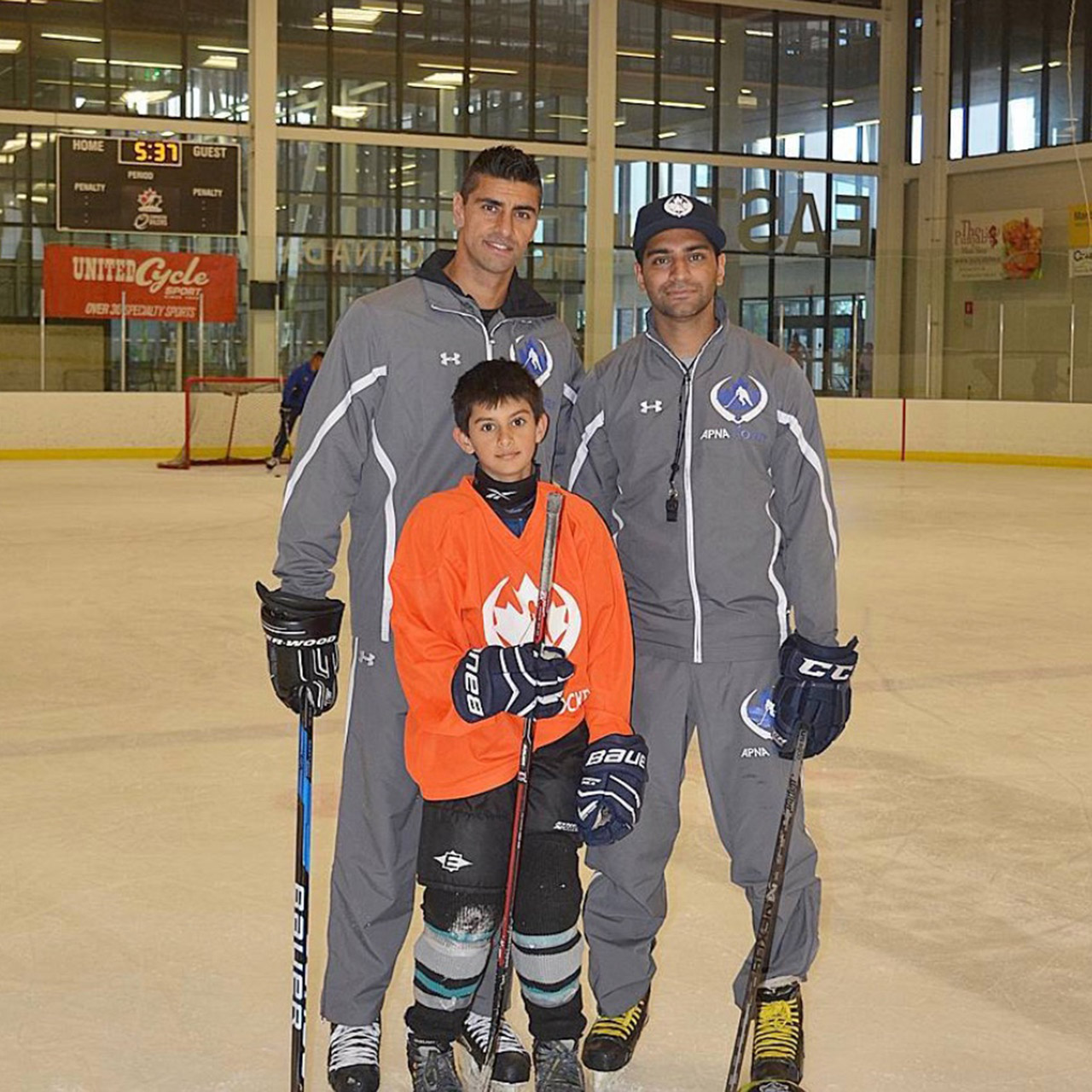
In the four years since, the organization has grown immensely. What started as an Instagram account to show South Asian kids they have brown role models in the game has become a multi-faceted network aimed at changing the complexion of the sport as a whole. “Our main priority is to connect our South Asian community in the hockey world with mentors, with coaches, with media members. We want to be able to uplift and elevate this community,” says Toor. “[It’s] not for me or Damps or any individual person — Apna Hockey is for the South Asian community. It’s there as a network, a support network, where kids can look up and see other players playing at an elite level. Girls from our community that play minor hockey can look up to girls that are getting university-level scholarships.”
The support comes in more forms than inspiration alone — it’s also granted young South Asian kids a tangible path to play the game. In 2020, Apna Hockey partnered with Bauer to give away roughly 800 pieces of equipment to families who couldn’t otherwise afford them. Toor and Brar began designing First Shift programs — those specifically for families new to the sport — with the equipment company, too. They’re in talks with Edmonton Oilers brass in hopes of setting up Apna Hockey camps that would put kids on the ice alongside NHLers, with a greater vision of similar efforts in every Canadian NHL city. They’ve brought South Asian players out on the ice for training sessions aimed at teaching the finer details of the sport. That hockey school has now expanded from Alberta to the other side of the country, Brar running the on-ice sessions in Calgary while a trio of coaches brought on board in January — J.K. Gill, one of the first players of South Asian descent to suit up in the OHL, his brother J.C. Gill, and Simran Sandhu — work with kids in Ontario.
It’s all part of a larger vision. In Punjabi, ‘apna’ essentially means ‘our,’ and more than anything else, their goal from Day 1 has been to live up to that name — to make clear that this game is ours, too. Sandhu’s perspective was a crucial addition to that mission, given her own tumultuous history in the Greater Toronto Hockey League. “Being really young, being really vulnerable to comments you hear on the ice and off the ice, I was never really exposed to situations like that [before],” she says of the racially tinged barbs she’d received for the first time in those GTHL days. “And being the only girl, and the only South Asian female in the whole league, it was kind of disheartening.”
Like Toor, it was the weight of all she went through in those years that pushed Sandhu to join Apna Hockey’s cause, to try to build a better situation for the next generation. “I want to be there for those youths that are looking to start the sport and may be scared,” Sandhu says. “And even for parents who have those barriers in their head, of ‘Oh, I don’t know if my girl can play hockey. Can she even play in a boys’ league?’ I want to challenge that.”
It’s why another key facet of the organization’s efforts has been mentoring South Asian players at various levels as they go through their own trials on and off the ice. Toor knows firsthand the difficulty of trying to navigate those waters without that kind of support. “Just knowing that we’ve created a system where no one feels alone anymore, that’s what I feel really happy about,” he says. “Because when you feel that isolation, being alone, thinking you’re the only one, it’ll eat at you.”
He still doesn’t notice the eyes on him, even as he swings by just a few feet from the crowd, the scattered group waiting to take the ice watching him intently. But this time, Brar’s not distracted by the search for a glimpse of his reflection, not concerned with the state of his on-ice style. He’s looking instead at the young skater mirroring his strides, corralling passes and whipping them back with all the strength he can muster. The two glide through half-speed circles, parallel as they spin around the ice, all of Brar’s attention trained on the young man whose helmet bears the same No. 19 he once wore. It’s early afternoon on this sun-soaked March day in Calgary, and with Brar’s first session already done, his son — 13-year-old Saiva Brar — is stealing a moment out on the ice with his dad before the next class begins.
The rink they’re marking up has a quintessentially Albertan air about it. An outdoor pad covered by a massive white tent, it sits like a great, white barn amid swaths of open land. Through the gaps in the structure, you see cars float by in the distance down Springbank Rd., the dull whirr of their engines occasionally swelling and fading amid the sound of metal carving ice.
Brar throws a hitch into their pattern, catching a pass on the toe of his blade and darting forward quicker than expected, flipping the puck by Saiva’s left skate to test the defenceman’s readiness. The younger Brar’s eyes widen behind the protective cage of his helmet as he adjusts to handle the plot twist, ever awed by his dad’s handles. Later, when the day’s training sessions resume, Saiva will casually glide to the corner and stash his helmet on the bench, adjusting his hair before returning to his dad’s side to help set up the next drill. His own quiet moment of no-bucket glory.

If not for Saiva, Brar wouldn’t be here at this rink right now, wouldn’t have that white Apna Hockey logo over his heart, emblazoned proudly upon the black tracksuit he’s donned for these coaching sessions, because for a time it seemed Brar might be done with the game entirely. He needed a break from the constant grind after wrapping up his near-decade in the pros. And when he did return, the game dealt him two separate ACL tears, which, all told, kept him off of skates for four straight years. But then Saiva came along, and a few years later, his daughter Saachi. And seeing them begin to putter around on the ice, Brar felt compelled to help show the way. Serendipitous timing took care of the rest — he started taking a greater role in coaching Saiva’s teams, and started running sessions with him, Saachi and other kids in the area, paying for the ice out of his own pocket. And just as things began to crescendo, hinting at something bigger, he found himself at an Earl’s in Red Deer across the table from Lali Toor.
Brar’s been leading Apna Hockey’s on-ice operations in Calgary ever since, and his impact has been clear. You see it in Heer’s son, six-year-old Kamden, who’s trained with Brar from Day 1. Kamden idolizes the former pro, his passion for the game grounded in wanting to be just like Brar, Heer says. You see it in 12-year-old Jaden Gill, whose dad, Lakhvinder, has seen Brar go as far as setting up video calls outside of practice to teach his son extra drills. “There’s times where he’s actually FaceTimed my son and spent a good half hour with him,” Gill says. “Just trying to show him the best he could while at home on his own time.” You see it in the effort Brar’s invested in supporting South Asians in women’s hockey, hoping to show young Saachi it’s just as much her game as it is his. That message was never clearer than in 2018, when Brar and Hayley Wickenheiser helped bring India’s national women’s team from Ladakh to train in Canada, Saachi right there to take it all in.
The greatest impact Brar’s had, though, hasn’t come from the young skaters’ perception of him, but from his genuine understanding of them. From the chance he’s provided to finally learn from someone who understands who they are, where they come from, what they carry with them. What does that look like in practice? “Well, for one, he knows my son’s name,” says Gurp Tumber, whose 10-year-old has been working with Brar for years. “There have been coaches who couldn’t even pronounce his name. My son’s name’s not that hard — it’s Sahaj. (But) he’s been called ‘Sam.’ He’s been called ‘SJ.’ Like, coaches will just change his name.
“How are you going to teach a kid when you can’t even pronounce his name? … That kind of stuff’s not necessary when it comes to Dampy.”
All of the days, months and years of work he’s put in ultimately came together in a single moment when Brar was named the winner of the NHL’s Willie O’Ree Community Hero Award in September 2020. But the joy it brought him wasn’t found in the trophy itself, or even the spotlight. What mattered more was what it said about all the effort he and Toor had poured in — what it said about the entire Apna Hockey vision. “When he called me and told me, I started crying,” says Toor. “We were finally acknowledged, finally acknowledged by the NHL, saying, ‘You guys are onto something. You guys are doing something that’s bigger than just North American hockey.’”
For a zealous commitment to growing and enhancing Canada's largest team.
Congratulations to Dampy Brar on winning the Willie O’Ree Community Hero Award. @HockeyAlberta | #makehockeymore pic.twitter.com/ujCf8nEluc
— Hockey Canada (@HockeyCanada) September 9, 2020
It was also recognition of a journey that started long before, though. It was recognition of those younger days in Sparwood, where Heer says Brar was — even as a kid — always teaching, always bringing in younger kids to join their games, telling everyone else to take it easy on them. Even as the town’s star player, his focus was ensuring everyone felt involved, included. It was recognition of that four-city rookie-year grind, when the game tried to push him out, and he refused to relent. It was recognition of Tacoma, where even while living in a country that had grown hostile to those who looked like him, Brar continued to answer questions, continued to educate those around him about his love for the culture that made him.
The accumulation of all those bricks laid Brar’s path to his spotlight moment, quite literally — while O’Ree and the NHL selected three finalists out of more than 700 applicants, it was a public vote that took Brar the rest of the way. And the votes poured in from everywhere — from Sparwood, from Tacoma, from Calgary, even from his parents’ village in India. Those years of love for the communities around him were answered with an outpouring of love right back. Brar’s wife, Gurdeep, who spearheaded the entire nomination and voting operation, smiles wide when she thinks back to the moment their family found out he’d won. “Saiva started bawling. They were hugging each other,” she remembers. “It was so sweet.”
“It was unbelievable,” says Saiva. “I was tearing up. Our whole family was in shock.”
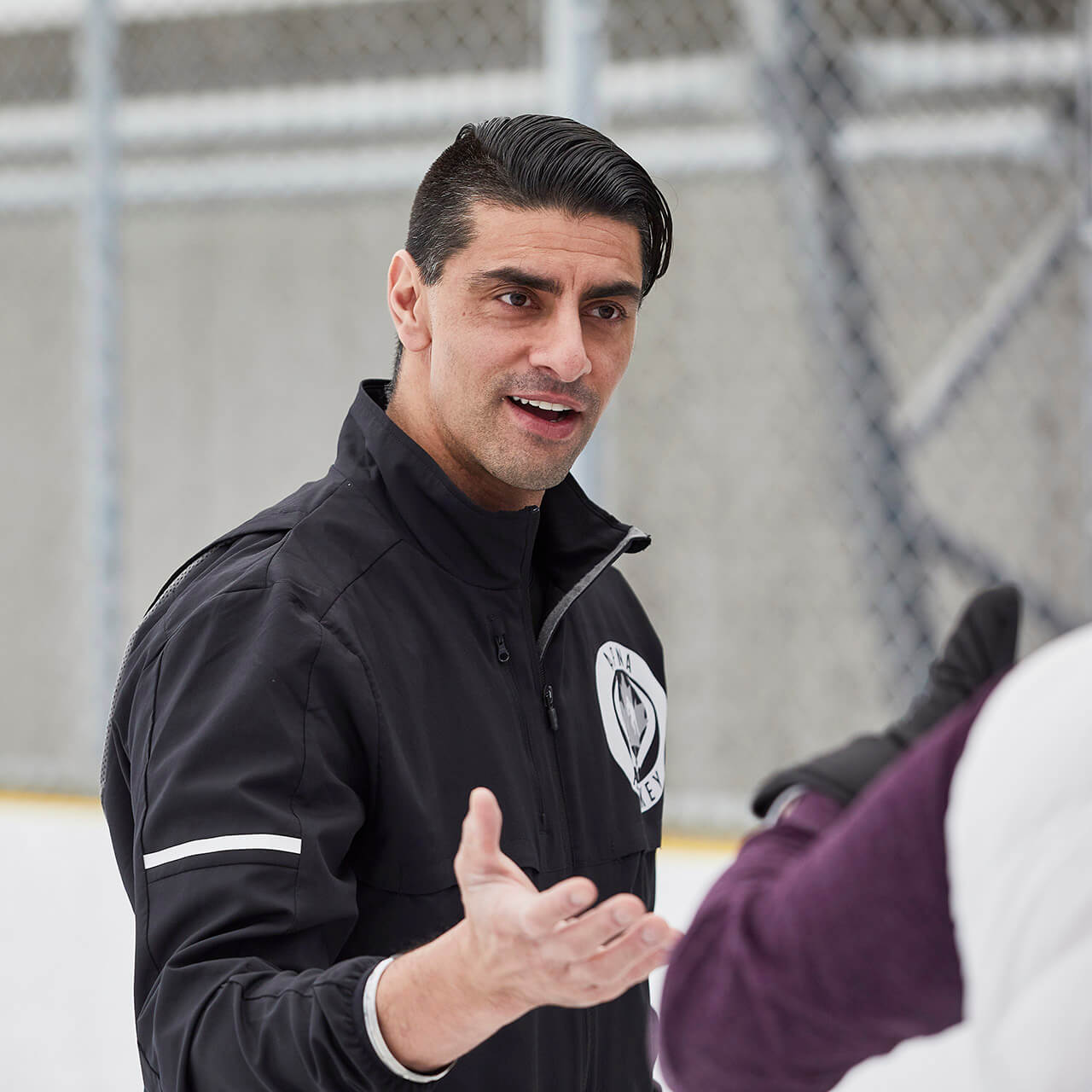
It wasn’t until Brar had moved away to America that his father finally opened up to him about what he himself had faced back in Sparwood. When Brar was younger, he would tell his parents whenever the rare situation would arise — a racist comment on the ice, an altercation. Ram would always say, “Don’t worry. Be strong.” He’d tell his son to beat them on the ice, beat them with his skill. So Brar took that to heart — when those situations arose, he steeled himself. In Huntsville, in Anchorage, he’d smile back at the perplexed faces, laugh off the biting remarks. “It made me strong-willed. So, when I faced it, I wasn’t too bothered by it,” he says. “I remembered it, there’s no question. It would always stick with me. But I never let it affect who I am.”
Eventually, Ram felt it was time to tell his son the full story, opening up about the discrimination he’d faced back when he was a Dryer Control Operator for Sparwood’s Westar Mining. He told him about the comments he’d get from white coworkers, about the tense situations that would ensue. “But he said, ‘I knew my place. That I needed to take it.’”
It’s a familiar sentiment. For first-generation Canadians whose parents came here for a better life, a different life, it’s one we know well — the idea that those who made that journey feel they aren’t owed a freedom quite the same as ours. Hasan Minhaj, the California-born comedian whose parents immigrated from India in the ’80s, touched on this idea in his 2017 special Homecoming King. He recalls a moment, in the days after 9/11, when his father answered the phone to a barrage of racial epithets screamed in his ear, and when the family heard, minutes later, the windows of their car being smashed outside. He remembers his father quietly sweeping the broken glass from the street, and what he said as he did.
“He looks at me and goes, ‘Hasan, these things happen, and these things will continue to happen. That’s the price we pay for being here.’ That’s when I was like, oh, we really are from two different generations,” Minhaj says in the film. “My dad’s from that generation, like a lot of immigrants, where he feels if you come to this country, you pay this thing like the ‘American Dream Tax’ — you’re going to endure some racism, and if it doesn’t cost you your life, well hey, you lucked out…. But for me, like a lot of us, I was born here. So I actually have the audacity of equality.”
It’s that same audacity that lies at the heart of all Apna Hockey does — the notion that equality is owed, not earned. That in hockey, like anywhere else, difference doesn’t make you deserving of discrimination. It’s what Brar described to O’Ree when he spoke to the legendary trailblazer early on in the award process.
“If you win, what are you going to do?” O’Ree asked him.
“Mr. O’Ree, you’re an ambassador for the game. You broke barriers. I want to replicate that,” Brar replied. “I want to do what you’re doing, but with our South Asian community. I want to grow the game. I want to be a voice when diversity and racism and inclusion come into play. We want to connect our communities, so that we’re one…. I want to go to different cities to do hockey camps and just spread the game of hockey, the love of hockey.”
The goal, for both Brar and Toor, is as plain as it is powerful, as obvious as it is ambitious. Support those who come next, give them the opportunity to thrive, and create space for their voices to be heard. That simple blueprint is why Apna Hockey came to be at all.
“When I was playing, I was voiceless. I was unknown. I had no platform,” says Toor. “So we created a platform for our community to speak out.”


